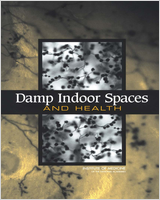NCBI Bookshelf. A service of the National Library of Medicine, National Institutes of Health.
Almost all homes, apartments, and commercial buildings will experience leaks, flooding, or other forms of excessive indoor dampness at some point. Not only is excessive dampness a health problem by itself, it also contributes to several other potentially problematic types of situations. Molds and other microbial agents favor damp indoor environments, and excess moisture may initiate the release of chemical emissions from damaged building materials and furnishings. This new book from the Institute of Medicine examines the health impact of exposures resulting from damp indoor environments and offers recommendations for public health interventions.
Damp Indoor Spaces and Health covers a broad range of topics. The book not only examines the relationship between damp or moldy indoor environments and adverse health outcomes but also discusses how and where buildings get wet, how dampness influences microbial growth and chemical emissions, ways to prevent and remediate dampness, and elements of a public health response to the issues. A comprehensive literature review finds sufficient evidence of an association between damp indoor environments and some upper respiratory tract symptoms, coughing, wheezing, and asthma symptoms in sensitized persons. This important book will be of interest to a wide-ranging audience of science, health, engineering, and building professionals, government officials, and members of the public.
Contents
- THE NATIONAL ACADEMIES
- COMMITTEE ON DAMP INDOOR SPACES AND HEALTH
- Reviewers
- Acknowledgments
- Executive Summary
- 1. Background and Methodologic Considerations
- 2. Damp Buildings
- MOISTURE DEFINITIONS
- MOISTURE DYNAMICS IN BUILDINGS—HOW BUILDINGS GET WET
- PREVALENCE, SEVERITY, LOCATION, AND DURATION OF BUILDING DAMPNESS
- RISK FACTORS FOR MOISTURE PROBLEMS
- FROM MOISTURE TO MICROBIAL GROWTH
- MICROORGANISMS OCCURRING IN INDOOR SPACES AND ON BUILDING MATERIALS
- DAMPNESS-RELATED PROBLEMS NOT ASSOCIATED WITH BIOLOGIC SOURCES
- SUMMARY
- FINDINGS, RECOMMENDATIONS, AND RESEARCH NEEDS
- REFERENCES
- 3. Exposure Assessment
- 4. Toxic Effects of Fungi and Bacteria
- 5. Human Health Effects Associated with Damp Indoor Environments
- 6. Prevention and Remediation of Damp Indoor Environments
- 7. The Public Health Response
- Appendix A Workshop Presentations and Speakers
- Appendix B Committee, Consultant, and Staff Biographies
This study was supported by Contract No. 200-2000-0629, TO #08 between the National Academy of Sciences and Centers for Disease Control and Prevention. Any opinions, findings, conclusions, or recommendations expressed in this publication are those of the author(s) and do not necessarily reflect the view of the organizations or agencies that provided support for this project.
NOTICE: The project that is the subject of this report was approved by the Governing Board of the National Research Council, whose members are drawn from the councils of the National Academy of Sciences, the National Academy of Engineering, and the Institute of Medicine. The members of the committee responsible for the report were chosen for their special competences and with regard for appropriate balance.
- NLM CatalogRelated NLM Catalog Entries
- Fungal Signature of Moisture Damage in Buildings: Identification by Targeted and Untargeted Approaches with Mycobiome Data.[Appl Environ Microbiol. 2020]Fungal Signature of Moisture Damage in Buildings: Identification by Targeted and Untargeted Approaches with Mycobiome Data.Adams RI, Sylvain I, Spilak MP, Taylor JW, Waring MS, Mendell MJ. Appl Environ Microbiol. 2020 Aug 18; 86(17). Epub 2020 Aug 18.
- Review Remediating buildings damaged by dampness and mould for preventing or reducing respiratory tract symptoms, infections and asthma (Review).[Evid Based Child Health. 2013]Review Remediating buildings damaged by dampness and mould for preventing or reducing respiratory tract symptoms, infections and asthma (Review).Sauni R, Uitti J, Jauhiainen M, Kreiss K, Sigsgaard T, Verbeek JH. Evid Based Child Health. 2013 May; 8(3):944-1000.
- Hydrophilic fungi and ergosterol associated with respiratory illness in a water-damaged building.[Environ Health Perspect. 2008]Hydrophilic fungi and ergosterol associated with respiratory illness in a water-damaged building.Park JH, Cox-Ganser JM, Kreiss K, White SK, Rao CY. Environ Health Perspect. 2008 Jan; 116(1):45-50.
- NIOSH Dampness and Mold Assessment Tool (DMAT): Documentation and Data Analysis of Dampness and Mold-Related Damage in Buildings and Its Application.[Buildings (Basel). 2022]NIOSH Dampness and Mold Assessment Tool (DMAT): Documentation and Data Analysis of Dampness and Mold-Related Damage in Buildings and Its Application.Park JH, Cox-Ganser JM. Buildings (Basel). 2022 Jul; 12(8):1075-1092.
- Review Dampness in buildings as a risk factor for health effects, EUROEXPO: a multidisciplinary review of the literature (1998-2000) on dampness and mite exposure in buildings and health effects.[Indoor Air. 2004]Review Dampness in buildings as a risk factor for health effects, EUROEXPO: a multidisciplinary review of the literature (1998-2000) on dampness and mite exposure in buildings and health effects.Bornehag CG, Sundell J, Bonini S, Custovic A, Malmberg P, Skerfving S, Sigsgaard T, Verhoeff A, EUROEXPO. Indoor Air. 2004 Aug; 14(4):243-57.
- Damp Indoor Spaces and HealthDamp Indoor Spaces and Health
- WHO Guidelines for Indoor Air QualityWHO Guidelines for Indoor Air Quality
- Vamp4 vesicle-associated membrane protein 4 [Mus musculus]Vamp4 vesicle-associated membrane protein 4 [Mus musculus]Gene ID:53330Gene
- LIMCH1 LIM and calponin homology domains 1 [Homo sapiens]LIMCH1 LIM and calponin homology domains 1 [Homo sapiens]Gene ID:22998Gene
- Raly hnRNP-associated with lethal yellow [Mus musculus]Raly hnRNP-associated with lethal yellow [Mus musculus]Gene ID:19383Gene
Your browsing activity is empty.
Activity recording is turned off.
See more...
